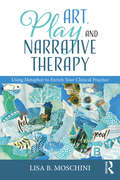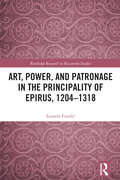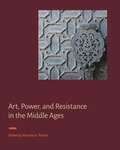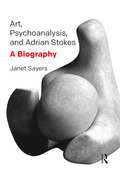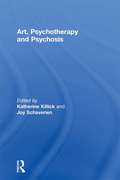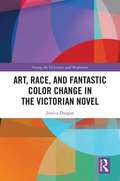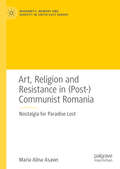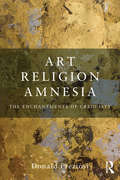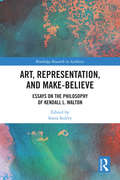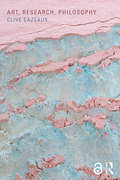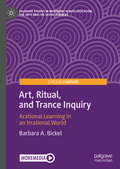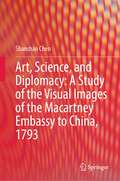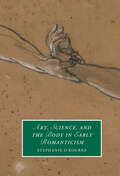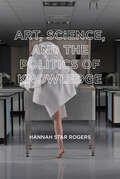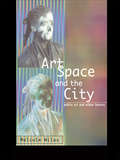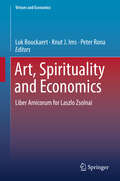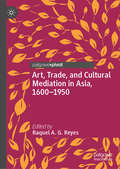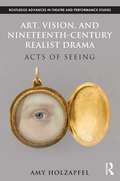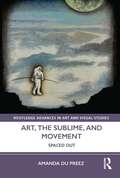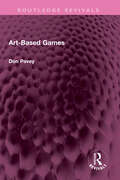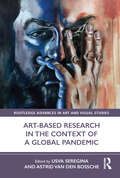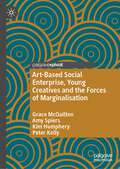- Table View
- List View
Art, Play, and Narrative Therapy: Using Metaphor to Enrich Your Clinical Practice
by Lisa B. MoschiniArt, Play, and Narrative Therapy shows mental health professionals how the blending of expressive arts, psychotherapy, and metaphorical communication can both support and enhance clinical practice. This book illuminates the ways in which metaphorical representations form who we are, how we interact, and how we understand our larger environment. Author Lisa Moschini explains how to couple clients’ words, language, stories, and artwork with treatment interventions that aid empathic understanding, promote a collaborative alliance, and encourage conflict resolution. Chapters include numerous illustrations, exercises, and examples that give clinicians inspiration for both theoretical and practical interventions.
Art, Power, and Patronage in the Principality of Epirus, 1204–1318 (Routledge Research in Byzantine Studies)
by Leonela FundićThe Principality of Epirus was a medieval Greek state established in the western part of the Balkans after the fall of Constantinople to the forces of the Fourth Crusade in 1204. The Epirote rulers from the Komnenos Doukas family claimed to be legitimate successors to the Byzantine imperial throne and, with the support of the high clergy and the aristocracy within their domain, carefully maintained their Byzantine identity under the conditions of exile. This book explores a corpus of Epirote architecture, frescoes, sculpture, and inscriptions from the early thirteenth to the early fourteenth century within a comparative and interdisciplinary framework, focusing on the nexus of art, patronage, and political ideology. Through an examination of a vast array of visual and textual sources, many of them understudied or hitherto unpublished, the book uncovers how the Epirote elite mobilised art and material culture to address the issues of succession and legitimacy, construct memory, reclaim Constantinople, and mediate encounters and exchanges with the Latin West. In doing so, this study offers a new perspective on Byzantine political and cultural history in the aftermath of the Fourth Crusade.
Art, Power, and Resistance in the Middle Ages (Signa: Papers of the Index of Medieval Art at Princeton University)
by Pamela A. PattonThis volume addresses a vital point of intersection between images in the Middle Ages and those in the modern world: the potential of medieval works of art to convey messages of power and resistance. Provoked by the misuse of medieval imagery in modern discussions, the contributors to this volume assess how medieval images connect to discourses of power in both the past and the present.The contributors each began with a single question: In the eyes of their makers and viewers, how were medieval images understood to assert or to resist forces of power? Their case studies come from a wide range of cultural, geographic, and historical contexts: the Byzantine, Ottonian, and Valois courts; the Umayyad and Castilian regimes of the Iberian Peninsula; the pluralistic military and commercial zones of the eastern Mediterranean; and the metaphorical as well as personal battlegrounds linked to medieval “courtly love” culture. Over eight chapters, the authors highlight patterns of visual rhetoric still evident in art today. They invite readers to contemplate how modern priorities and sensibilities might amplify, mute, or transform the discourses related to power and resistance that were threaded through the visual culture of the Middle Ages.This insightful book should be of value to anyone interested in medieval art history and art’s relationship to power and authority in society.In addition to the editor, the contributors include Heather A. Badamo, Elena N. Boeck, Thomas E. A. Dale, Martha Easton, Eliza Garrison, Anne D. Hedeman, Tom Nickson, and Avinoam Shalem.
Art, Psychoanalysis, and Adrian Stokes: A Biography
by Janet SayersIllustrated with Barbara Hepworth's abstract stone carving, with other works of art, and with fascinating vignettes from Adrian Stokes's writing, this biography highlights his revolutionary emphasis on the materials-led inspiration of architecture, sculpture, painting, and the avant-garde creations of the Ballets Russes. In also detailing Stokes's role as catalyst of the transformation of St Ives in Cornwall into an internationally-acclaimed centre of modern art, and his falling in love again in his early forties, this biography shows how Stokes used all these experiences, together with his many years of psychoanalytic treatment by Melanie Klein, in forging insights about ways the outer world gives form to the inner world of fantasy and imagination.
Art, Psychotherapy and Psychosis
by Joy Schaverien Katherine KillickArt, Psychotherapy and Psychosis reveals the unique role of art therapy in the treatment of psychosis. Illustrating their contributions with clinical material and artwork created by clients, experienced practitioners describe their work in a variety of settings. Writing from different theoretical standpoints they reflect the current creative diversity within the profession and its links with psychotherapy, psychoanalysis, analytical psychology and psychiatry.In part I specific issues involved in working with psychosis are explored. These include discussion of the therapeutic relationship, the process of symbolisation, the nature and meaning of art made by psychotic patients and the interplay between words and pictures. Part II recounts the history of art therapy and psychosis, tracing its origins in art, to its present-day role as a respected treatment in psychiatric, community and therapeutic settings.Art, Psychotherapy and Psychosis extends the existing theory, develops analytical approaches in art psychotherapy and offers innovative perspectives for students and practitioners on the treatment of borderline states as well as psychosis.
Art, Race, and Fantastic Color Change in the Victorian Novel (Among the Victorians and Modernists)
by Jessica DurganAs a study of color in the Victorian novel, this volume notices and analyzes a peculiar literary phenomenon in which Victorian authors who were also trained as artists dream up fantastically colored characters for their fiction. These strange and eccentric characters include the purple madwoman Bertha Mason in Charlotte Brontë’s Jane Eyre (1847), the blue gentleman Oscar Dubourg from Wilkie Collins’s Poor Miss Finch (1872), the red peddler Diggory Venn in Thomas Hardy’s The Return of the Native (1878), and the little yellow girls of Arthur Conan Doyle’s "The Yellow Face" (1893) and Frances Hodgson Burnett’s The Secret Garden (1911). While color has been historically viewed as suspicious and seductive in Western culture, the Victorian period constitutes a significant moment in the history of color: the rapid development of new color technologies and the upheavals of the first avant-garde art movements result in an increase in coloring’s prestige in the art academies. At the same time, race science appropriates color, using it as a criterion for classification in the establishment of global racial hierarchies. These artist-authors draw on color’s traditional association with constructions of otherness to consider questions of identity and difference through the imaginative possibilities of color.
Art, Religion and Resistance in: Nostalgia for Paradise Lost (Modernity, Memory and Identity in South-East Europe)
by Maria Alina AsaveiThis book illuminates the interconnections between politics and religion through the lens of artistic production, exploring how art inspired by religion functioned as a form of resistance, directed against both Romanian national communism (1960-1989) and, latterly, consumerist society and its global market. It investigates the critical, tactical and subversive employments of religious motifs and themes in contemporary art pieces that confront the religious ‘affair’ in post-communist Romania. In doing so, it addresses a key gap in previous scholarship, which has paid little attention to the relationship between religious art and political resistance in communist Central and South-East Europe.
Art, Religion, Amnesia: The Enchantments of Credulity
by Donald PreziosiArt, Religion, Amnesia addresses the relationship between art and religion in contemporary culture, directly challenging contemporary notions of art and religion as distinct social phenomena and explaining how such Western terms represent alternative and even antithetical modes of world-making. In this new book, Professor Preziosi offers a critique of the main thrust of writing in recent years on the subjects of art, religion, and their interconnections, outlining in detail a perspective which redefines the basic terms in which recent debates and discussions have been articulated both in the scholarly and popular literature, and in artistic, political and religious practice. Art, Religion and Amnesia proposes an alternative to the two conventional traditions of writing on the subject which have been devoted on the one hand to the ‘spiritual’ dimensions of artistry, and on the other hand to the (equally spurious) ‘aesthetic’ aspects of religion. The book interrogates the fundamental assumptions fuelling many current controversies over representation, idolatry, blasphemy, and political culture. Drawing on debates from Plato’s proposal to banish representational art from his ideal city-state to the Danish cartoons of Mohamed, Preziosi argues that recent debates have echoed a number of very ancient controversies in political philosophy, theology, and art history over the problem of representation and its functions in individual and social life. This book is a unique re-evaluation of the essential indeterminacy of meaning-making, marking a radically new approach to understanding the inextricability of aesthetics and theology and will be of interest to students and researchers in art history, philosophy and religion and cultural theory.
Art, Representation, and Make-Believe: Essays on the Philosophy of Kendall L. Walton (Routledge Research in Aesthetics)
by Sonia SedivyThis is the first collection of essays focused on the many-faceted work of Kendall L. Walton. Walton has shaped debate about the arts for the last 50 years. He provides a comprehensive framework for understanding arts in terms of the human capacity of make-believe that shows how different arts – visual, photographic, musical, literary, or poetic – can be explained in terms of complex structures of pretense, perception, imagining, empathy, and emotion. His groundbreaking work has been taken beyond aesthetics to address foundational issues concerning linguistic and scientific representations – for example, about the nature of scientific modelling or to explain how much of what we say is quite different from the literal meanings of our words. Contributions from a diverse group of philosophers probe Walton’s detailed proposals and the themes for research they open. The essays provide an overview of important debates that have Walton’s work at their core. This book will be of interest to scholars and graduate students working on aesthetics across the humanities, as well as those interested in the topic of representation and its intersection with perception, language, science, and metaphysics.
Art, Research, Philosophy
by Clive CazeauxArt, Research, Philosophy explores the emergent field of artistic research: art produced as a contribution to knowledge. As a new subject, it raises several questions: What is art-as-research? Don’t the requirements of research amount to an imposition on the artistic process that dilutes the power of art? How can something subjective become objective? What is the relationship between art and writing? Doesn’t description always miss the particularity of the artwork? This is the first book-length study to show how ideas in philosophy can be applied to artistic research to answer its questions and to make proposals for its future. Clive Cazeaux argues that artistic research is an exciting development in the historical debate between aesthetics and the theory of knowledge. The book draws upon Kant, phenomenology and critical theory to show how the immediacies of art and experience are enmeshed in the structures that create knowledge. The power of art to act on these structures is illustrated through a series of studies that look closely at a number of contemporary artworks. This book will be ideal for postgraduate students and scholars of the visual and creative arts, aesthetics and art theory.
Art, Ritual, and Trance Inquiry: Arational Learning in an Irrational World (Palgrave Studies in Movement across Education, the Arts and the Social Sciences)
by Barbara A. BickelThis book provides insights into the practice of trance-based inquiry through arts-based research, serving as a beacon to guide the way to thresholds of ancient, yet novel, transmissions. Embedded in lived experience and theory, this book introduces the reader to the liminal space of place and trance-based inquiry processes entwined with creative artworkings. The interweaving of art, ritual, and trance-based inquiry opens sacred spaces for learning and unlearning that bring spirit into form. Each chapter presents examples from women artists and culminates with experiential practices drawn from the author’s decades of creative peregrinations to assist artists, teachers, and researchers in transmitting a conscious way of practicing and creating with trance.
Art, Science, and Diplomacy: A Study of the Visual Images of the Macartney Embassy to China, 1793
by Shanshan ChenThis book examines how the Embassy members approached, selected, and represented information, and how, in doing so, they helped to shape European perceptions of China. The Macartney Embassy of 1793 was the first British diplomatic mission to China, seeking to open ties between the two empires. As part of the mission, the British government commissioned writers and artists to chronicle the geography and culture of a civilization that had, until then, been shrouded in mystery. A central focus of the book is the artwork itself, which provides a window into the diplomatic, artistic and scientific viewpoints underlying the mission. Drawing on archival research, the study recreates the processes through which the Embassy’s draughtsmen, scientists, and diplomats collaborated to represent the visual images, and how the materials were reworked for publication in London. The finished product demonstrates that the artists offered a distinct viewpoint in the representation of China, sometimes differing from the textual accounts, by blending scientific elements and artistic aesthetics in order to demystify China and make it more knowable to a British audience. It was in the interposition of text and image that the British public formulated an ambivalent perception of China that embraced both admiration and disdain. In addition to the scholars, the book targets general readers who are interested in global art and history, and East–West interactions. It contains important images with detailed visual and historical analysis that enable readers to acquire knowledge on how the British represented China and how that image helped to shape the European perception of China during the British global expansion in the eighteenth and nineteenth centuries, and beyond.
Art, Science, and the Body in Early Romanticism (Cambridge Studies in Romanticism)
by Stephanie O'RourkeCan we really trust the things our bodies tell us about the world? This work reveals how deeply intertwined cultural practices of art and science questioned the authority of the human body in the late eighteenth and early nineteenth centuries. Focusing on Henry Fuseli, Anne-Louis Girodet and Philippe de Loutherbourg, it argues that romantic artworks participated in a widespread crisis concerning the body as a source of reliable scientific knowledge. Rarely discussed sources and new archival material illuminate how artists drew upon contemporary sciences and inverted them, undermining their founding empiricist principles. The result is an alternative history of romantic visual culture that is deeply embroiled in controversies around electricity, mesmerism, physiognomy and other popular sciences. This volume reorients conventional accounts of romanticism and some of its most important artworks, while also putting forward a new model for the kinds of questions that we can ask about them.
Art, Science, and the Politics of Knowledge
by Hannah Star RogersHow the tools of STS can be used to understand art and science and the practices of these knowledge-making communities.In Art, Science, and the Politics of Knowledge, Hannah Star Rogers suggests that art and science are not as different from each other as we might assume. She shows how the tools of science and technology studies (STS) can be applied to artistic practice, offering new ways of thinking about people and objects that have largely fallen outside the scope of STS research. Arguing that the categories of art and science are labels with specific powers to order social worlds—and that art and science are best understood as networks that produce knowledge—Rogers shows, through a series of cases, the similarities and overlapping practices of these knowledge communities. The cases, which range from nineteenth-century artisans to contemporary bioartists, illustrate how art can provide the basis for a new subdiscipline called art, science, and technology studies (ASTS), offering hybrid tools for investigating art–science collaborations. Rogers&’s subjects include the work of father and son glassblowers, the Blaschkas, whose glass models, produced in the nineteenth century for use in biological classification, are now displayed as works of art; the physics photographs of documentary photographer Berenice Abbott; and a bioart lab that produces work functioning as both artwork and scientific output. Finally, Rogers, an STS scholar and contemporary art–science curator, draws on her own work to consider the concept of curation as a form of critical analysis.
Art, Space and the City
by Malcolm MilesPublic art - the making, management and mediation of art outside its conventional location in museums and galleries, and the livable city - a concept involving user-centred strategies for urban planning and design, are both socially produced but have emerged from different fields and tend to be discussed in isolation.This book applies a range of critical perspectives which have emerged from different disciplines - art criticism, urban design, urban sociology, geography and critical theory - to examine the practice of art for urban public spaces, seeing public art from positions outside those of the art world to ask how it might contribute to possible urban futures. Exploring the diversity of urban politics, the functions of public space and its relation to the structures of power, the roles of professionals and users in the construction of the city, the gendering of space and the ways in which space and citizen are represented, the book explains how these issues are as relevant to architecture, urban design and urban planning as they are to public art. Drawing on a wealth of images from across the UK and Europe and the USA, in particular, the author questions the effectiveness of public art in achieving more convivial urban environments, whilst retaining the idea that imagining possible futures is as much part of a democratic society as using public space.
Art, Spirituality and Economics: Liber Amicorum for Laszlo Zsolnai (Virtues and Economics #2)
by Luk Bouckaert Peter Rona Knut J. ImsThis volume celebrates the work of Laszlo Zsolnai, a leading researcher and scholar in the field of the ethical and spiritual aspects of economic life, who has made significant contributions to the connection between ethics, spirituality, aesthetics and economic theory. <P><P>The book offers a selection of essays concerned with the ethical, spiritual and aesthetic context within which economics as a social studies discipline should be situated in order to avoid the sort of dehumanising consequences that theories based on utility maximisation and rational choice necessarily entail. It presents the economic activities of human beings not as some sort of preordained obedience to universal laws that operate independently of other human concerns, but, rather, as a part of the human desire for the Aristotelian good life. It looks at the various considerations –moral, spiritual and aesthetic – that take part in the formation of economic decisions in sharp contrast with theories that purport to explain economic phenomena solely on the basis of utility maximisation.
Art, Trade, and Cultural Mediation in Asia, 1600–1950
by Raquel A. ReyesThis Palgrave Pivot explores the social and cultural impact of global trade at a micro-level from around 1600 to 1950. Bringing together the collaborative skills of cultural, social, economic, and art historians, it examines how the diffusion of trade, goods and objects affected people’s everyday lives. The authors tell several stories: of the role played by a host of intermediaries – such as apothecaries, artisans and missionaries who facilitated the process; of objects such as Japanese export lacquer-ware and paintings; of how diverse artistic influences came to be expressed in colonial church architecture in the Philippines; of revolutionary changes wrought on quotidian tastes and preferences, as shown in the interior decoration of private homes in the Dutch East Indies; and of transformations in the smoking and drinking habits of Southeast Asians. The chapters consider the conditions from which emerged new forms of artistic production and transfer, fresh cultural interpretations, and expanded markets for goods, objects and images.
Art, Vision, and Nineteenth-Century Realist Drama: Acts of Seeing (Routledge Advances in Theatre & Performance Studies)
by Amy HolzapfelRealism in theatre is traditionally defined as a mere seed of modernism, a crude attempt to reproduce an exact copy of reality on stage. Art, Vision & Nineteenth-Century Realist Drama redefines realism as a complex and under-examined form of visual modernism, one that positioned theatre at the crux of the encounter between consciousness and the visible world. Tracing a historical continuum of "acts of seeing" on the realist stage, Holzapfel demonstrates how theatre participated in modernity’s aggressive interrogation of vision’s residence in the human body. New findings by scientists and philosophers—such as Diderot, Goethe, Müller, Helmholtz, and Galton—exposed how the visible world is experienced and framed by the unstable relativism of the physiological body rather than the fixed idealism of the mind. Realist artists across media paradoxically embraced this paradigm shift by focusing on the embodied observer. Drawing from extensive archival research, Holzapfel conducts close readings of iconic dramas and their productions—including Scribe’s The Glass of Water, Zola’s Thérèse Raquin, Ibsen’s A Doll House, Strindberg’s The Father, and Hauptmann’s Before Sunrise—alongside analyses of artwork by major painters and photographers—such as Chardin, Nadar, Millais, Rejlander, and Liebermann. In a radical challenge to existing criticism, Holzapfel argues that realism in theatre was never the attempt to reproduce an exact copy of the seen world but rather the struggle to make visible the act of seeing.
Art, the Sublime, and Movement: Spaced Out (Routledge Advances in Art and Visual Studies)
by Amanda du PreezThis book is a critical interdisciplinary approach to the study of contemporary visual culture and image studies, exploring ideas about space and place and ultimately contributing to the debates about being human in the digital age. The upward and downward pull seem in a constant contest for humanity’s attention. Both forces are powerful in the effects and affects they invoke. When tracing this iconological history, Amanda du Preez starts in the early nineteenth century, moving into the twentieth century and then spanning the whole century up to contemporary twenty-first century screen culture and space travels. Du Preez parses the intersecting pathways between Heaven and Earth, up and down, flying and falling through the concept of being “spaced out”. The idea of being “spaced out” is applied as a metaphor to trace the visual history of sublime encounters that displace Earth, gravity, locality, belonging, home, real life, and embodiment. The book will be of interest to scholars working in art history, visual culture, media and cultural studies, phenomenology, digital culture, mobility studies, and urban studies.
Art, the Sublime, and Movement: Spaced Out (Routledge Advances in Art and Visual Studies)
by Amanda du PreezThis book is a critical interdisciplinary approach to the study of contemporary visual culture and image studies, exploring ideas about space and place and ultimately contributing to the debates about being human in the digital age. The upward and downward pull seem in a constant contest for humanity’s attention. Both forces are powerful in the effects and affects they invoke. When tracing this iconological history, Amanda du Preez starts in the early nineteenth century, moving into the twentieth century and then spanning the whole century up to contemporary twenty-first century screen culture and space travels. Du Preez parses the intersecting pathways between Heaven and Earth, up and down, flying and falling through the concept of being “spaced out”. The idea of being “spaced out” is applied as a metaphor to trace the visual history of sublime encounters that displace Earth, gravity, locality, belonging, home, real life, and embodiment. The book will be of interest to scholars working in art history, visual culture, media and cultural studies, phenomenology, digital culture, mobility studies, and urban studies.
Art-Based Games (Routledge Revivals)
by Don PaveyThe visitor to an Art Arena game is confronted with an enormous piece of paper covering one wall of the room. Groups of players are at work painting, some with spontaneity or abandon, others with thoughtful precision. Back from the wall are knots of players calling our apparently cryptic information to those at work on the paper, or transmitting it in coded sounds using whistles, pipes and various home-made instruments. Colours are phased across the wall, sometimes colliding, sometimes mingling, or encircling each other. But what is the connection between the sound flow and the painting?This book, originally published in 1979, describes the beginnings of a new approach to art education – an approach based on the use of games in art. The games draw not only upon artistic and design skills, but also upon those that teachers in all subjects try to develop in their pupils: logical thinking, breadth of judgement, imagination and sensibility in handling materials and media. They also provide a vehicle for familiarizing players with a wealth of concepts and data from different topics. The approach aims at promoting group work and cooperative interaction, and has proved to be of interest to social workers and to teachers of disabled and difficult children. It has been tried out with an unusual variety of groups, from mixed and low ability to groups of gifted children, students and adults, and while the level of playing has varied, the games have elicited high involvement from participants.While referring to game theory and research, the book is essentially practical, giving instructions for inventing and playing games, and descriptions of a number of games played by different groups. The end of the book gives a detailed list of concepts and suggestions for further reading, and lists of materials and suppliers.
Art-Based Research
by Shaun McniffArt therapy and all of the other creative arts therapies have promoted themselves as ways of expressing what cannot be conveyed in conventional language. Why is it that creative arts therapists fail to apply this line of thinking to research? In this exciting and innovative book, Shaun McNiff, one of the field's pioneering educators and authors, breaks new ground in defining and inspiring art-based research. He illustrates how practitioner-researchers can become involved in art-based inquiries during their educational studies and throughout their careers, and shows how new types of research can be created that resonate with the artistic process. Clearly and cogently expressed, the theoretical arguments are illustrated by numerous case examples, and the final part of the book provides a wealth of ideas and thought provoking questions for research. This challenging book will prove invaluable to creative art therapy educators, students, and clinicians who wish to approach artistic inquiry as a way of conducting research. It will also find a receptive audience within the larger research community where there is a rising commitment to expanding the theory and practice of research. Integrating artistic and scientific procedures in many novel ways, this book offers fresh and productive visions of what research can be.
Art-Based Research in the Context of a Global Pandemic (Routledge Advances in Art and Visual Studies)
by Usva Seregina Van den Bossche, AstridLiving through the Covid-19 global pandemic has changed the way that we experience our lives, the way that we relate to one-another, and the way that we engage with the world. Focusing contextually on the initial lockdowns of the pandemic in 2020, this book proposes that art-based research has a central, illuminative role to play in our understanding of unfolding crises. The changes brought on by the global event may not be readily accessible or expressible through traditional academic research. Art-based research offers the opportunity to explore, document, and reflect on the emerging and often ineffable qualities of transformed lives by drawing on emotional, bodily, and interactive aspects of experience. Such an approach allows for meaning-making that makes room for reflexive, interpersonal, and dialogical engagement. The contributions aim to capture and explore lived experiences of the pandemic, as well as begin a discussion about how meaning-making is changing through and beyond the pandemic. This book further explores how the nature and practice of art-based research in itself has been challenged and transformed. The book will be of interest to scholars working in art education, art psychotherapy, consumer research, visual studies, cultural studies, and sociology.
Art-Based Social Enterprise, Young Creatives and the Forces of Marginalisation
by Peter Kelly Kim Humphery Grace McQuilten Amy SpiersThis book analyses the challenges and opportunities faced by art-based social enterprises (ASEs) engaging young creatives in education and training and supporting their pathways to the creative industries. In doing so, it addresses the complex intersecting issues of marginality and entrepreneurship, particularly in relation to young creatives from socially, economically and culturally diverse backgrounds. Drawing on extensive fieldwork and interviews with twelve key organisations, and three in-depth case studies in Australia, the book offers a detailed analysis of using enterprise to engage with the structural challenges of marginality. The book explores the local and global contexts through which art-based social enterprises (ASEs) operate and within which they attempt – often successfully – to improve access to education and work for emerging creatives. It also attends to the findings generated through engaging with the lived experiences of the staff and young creatives involved in our ASE case studies, in order to understand both the challenges and impacts of the ASE model on young people’s education, training, and employment pathways. The book focuses on three broad themes; precarious youth and digital futures, material practice and sustainable economies, and cultural citizenship in the urban fringe. In exploring these themes, the book contributes to debates about the limits, possibilities and challenges that attach to, and emerge from, an ASE model and highlights the ways in which these models can contribute to young people’s well-being, engagement, education and training, and work pathways. More broadly, it examines the possibilities of art as a means of social and cultural engagement. In the context of the precarious future of the creative industries, this book emphasise the ways in which young artists are building alternative economic and cultural models that support both individual pathways and collective change. This book will move the field forward with a critical lens that engages closely with experience and the lived realities of juggling multiple priorities of social, economic and artistic goals.
Art-Based Supervision: Cultivating Therapeutic Insight Through Imagery
by Barbara J. FishArt-Based Supervision is a unique text for graduate supervision classes and seminars as well as a resource for post-graduate supervisors and practitioners. It offers a new view of supervision, one that incorporates both images and words as tools to investigate and communicate the interactions that occur in therapy and in the systems in which clinicians work. The fundamental principles of supervision provided in the book are useful for anyone interested in exploring the use of images to support reflection, understanding, and empathy in their work. Full-color images further enrich the narrative. In addition to supervision courses, Art-based Supervision may be used for introductory art therapy, psychology, social work, and counseling courses for readers interested in a broad range of intimate examples of the challenges of therapeutic work and the use of response art to grasp nuanced communication.
